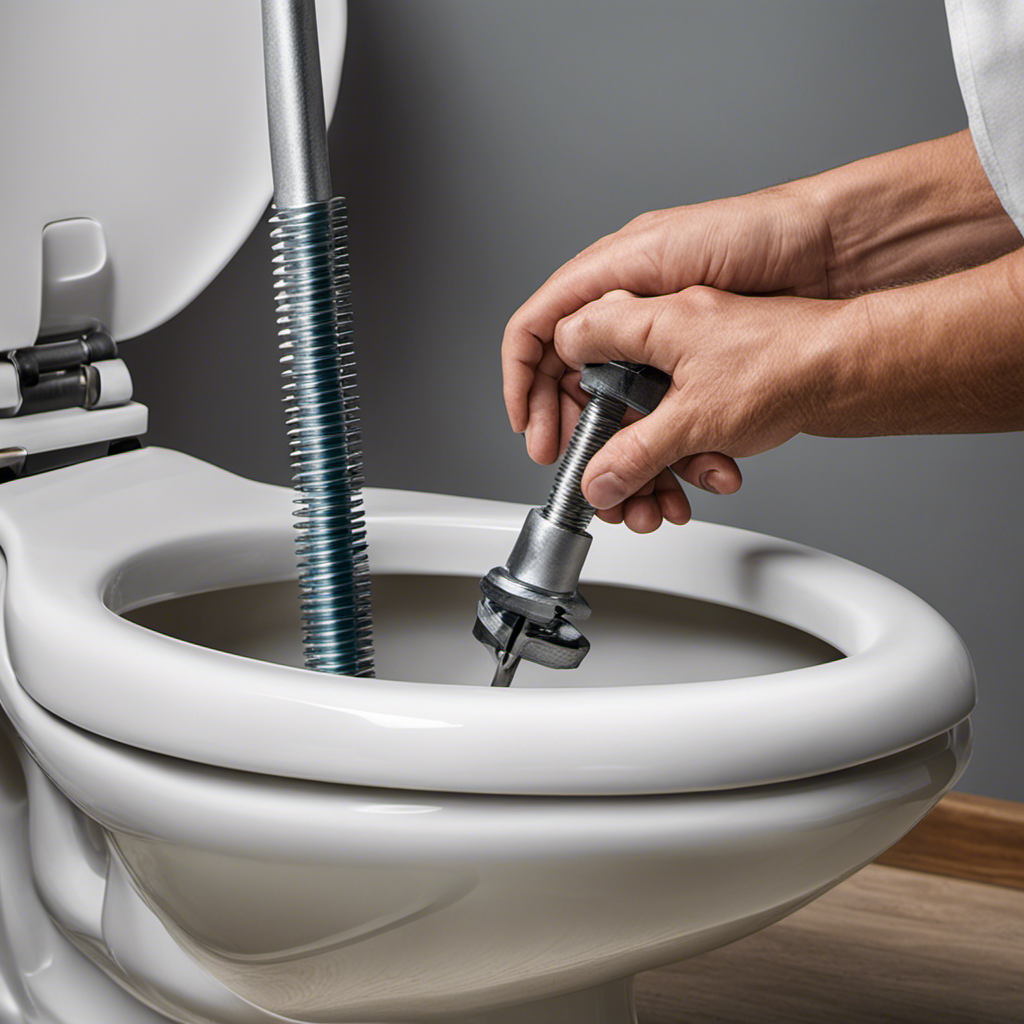As a plumbing enthusiast, I have always been fascinated by the inner workings of household fixtures. And when it comes to efficiency and water conservation, nothing beats a dual flush toilet.
So, let’s dive into the mechanics of this ingenious invention. How does it work? Well, with its dual flushing mechanism, it offers the option of a half flush for liquid waste and a full flush for solid waste. This clever design not only saves water, but also reduces your carbon footprint.
Let’s explore the fascinating world of dual flush toilets together.
Key Takeaways
- Dual flush technology promotes water conservation by offering two flushing modes: half flush and full flush.
- Half flush uses less water for liquid waste, while full flush releases a larger volume of water for solid waste.
- Dual flush toilets provide water efficiency, environmental benefits, and cost savings.
- Regular maintenance, such as cleaning, checking for leaks, and replacing worn parts, is important for optimal performance and to prevent water wastage.
The Mechanism of a Dual Flush Toilet
To understand how a dual flush toilet works, you need to know about its unique mechanism.
Dual flush technology is designed to promote water conservation by offering two different flushing options. The mechanism consists of two buttons or handles, one for a full flush and the other for a half flush.
The full flush is used for solid waste and provides a powerful flush by releasing a larger volume of water. On the other hand, the half flush is meant for liquid waste and uses less water.
When the user presses the appropriate button, the corresponding flush valve opens, allowing water to flow into the bowl and carry away waste. This mechanism allows for efficient water usage, saving gallons of water with each flush.
Understanding the mechanism of a dual flush toilet is crucial in comprehending its water-saving functionality.
Understanding Water Saving Functionality
You can easily understand how the water-saving feature functions in a dual flush toilet.
Dual flush toilets are designed with water conservation in mind and incorporate eco-friendly features.
The water-saving functionality is achieved through the use of two different flushing modes: half flush and full flush.
The half flush mode is meant for liquid waste and uses a smaller amount of water, typically around 0.8 gallons. This mode helps to save water by not using the full flush volume for waste that doesn’t require it.
On the other hand, the full flush mode is used for solid waste and utilizes a larger volume of water, usually around 1.6 gallons. This ensures effective waste removal while still conserving water compared to traditional toilets.
Understanding the differentiation between these two flush modes is crucial for optimizing water usage in a dual flush toilet.
Now, let’s delve into the specifics of how these modes are differentiated.
Differentiating Between Half and Full Flush Modes
Understanding the difference between the half and full flush modes in a dual flush toilet is important for optimizing water usage.
In the half flush mode, only a small amount of water is used, typically around 0.8 gallons, for liquid waste. This mode is designed for quick and efficient flushing, saving water without compromising cleanliness.
On the other hand, the full flush mode uses a higher volume of water, usually around 1.6 gallons, for solid waste. This mode ensures a more powerful flush to effectively remove waste from the bowl.
By offering these two flushing options, dual flush toilets provide significant water conservation benefits. The half flush mode saves water on a daily basis, while the full flush mode ensures proper waste removal.
This results in reduced water consumption and a positive environmental impact.
Benefits of Dual Flush Toilets
By offering two flushing options, dual flush toilets save water and reduce environmental impact. These toilets are designed with two buttons or levers, allowing users to choose between a half flush and a full flush.
Here are three benefits of dual flush toilets:
-
Water Efficiency: The dual flush system allows users to select the appropriate amount of water for each flush. The half flush option uses less water for liquid waste, while the full flush option provides more water for solid waste. This customized approach significantly reduces water consumption compared to traditional single flush toilets.
-
Environmental Impact: Dual flush toilets help to conserve water, a precious natural resource. By using less water per flush, these toilets minimize the strain on water supplies and reduce the need for water treatment and distribution. This ultimately leads to a decreased environmental impact and supports sustainable water management practices.
-
Cost Savings: With their water-saving capabilities, dual flush toilets can also lead to cost savings on water bills. By using less water, households can reduce their overall water consumption and lower their monthly expenses.
Dual flush toilets are an effective solution for improving water efficiency and reducing the environmental impact of toilet usage.
Maintenance and Troubleshooting Tips
Regular maintenance and troubleshooting can help ensure the proper functioning of dual flush toilets. By taking care of your toilet and addressing common issues promptly, you can avoid costly repairs and extend the life of your toilet. Here are some maintenance tips and common problems you may encounter:
| Maintenance Tips | Common Issues |
|---|---|
| Regular cleaning | Clogs |
| Checking for leaks | Weak flush |
| Adjusting the flush | Continuous running |
| Replace worn parts | Water seepage |
Regularly cleaning your toilet and checking for leaks are important maintenance tasks. Clogs can occur due to excessive waste or improper usage. Weak flushes can be caused by a faulty flush valve or water level adjustment. Continuous running may be a result of a worn-out flapper or a faulty fill valve. Water seepage can be resolved by replacing worn gaskets or seals. By following these maintenance tips and addressing common issues promptly, you can keep your dual flush toilet in optimal condition.
Frequently Asked Questions
How Much Water Does a Dual Flush Toilet Save Compared to a Traditional Toilet?
A dual flush toilet saves water by offering two flushing options: a low-volume flush for liquid waste and a higher-volume flush for solid waste. This water efficiency reduces the environmental impact of traditional toilets.
Are Dual Flush Toilets More Expensive Than Regular Toilets?
When comparing the cost of dual flush toilets to regular toilets, it’s important to consider the benefits. A thorough analysis will reveal that despite potentially higher upfront costs, dual flush toilets can save money in the long run due to water conservation.
Can I Retrofit My Existing Toilet to Be a Dual Flush Toilet?
Yes, you can retrofit your existing toilet to be a dual flush toilet. The retrofitting process involves installing a dual flush mechanism, which allows you to choose between a full flush or a half flush. The benefits of dual flush toilets include water conservation and cost savings.
Do Dual Flush Toilets Require Any Special Maintenance?
Yes, dual flush toilets do require some special maintenance. Regular cleaning and checking for leaks are important. However, the benefits of dual flush toilets, such as water conservation and cost savings, outweigh the maintenance requirements.
Can I Use Any Type of Toilet Paper in a Dual Flush Toilet?
Yes, you can use any type of toilet paper in a dual flush toilet. However, it is recommended to use toilet paper that is septic-safe to minimize the environmental impact and potential clogging.
Conclusion
In conclusion, the dual flush toilet is a remarkable innovation that brings together efficiency and conservation. Its mechanism, carefully designed to provide two flushing options, ensures optimal water usage. Whether it’s the half flush for liquid waste or the full flush for solid waste, this toilet allows us to make a conscious choice and reduce water wastage.
With its numerous benefits, such as cost savings and environmental impact, the dual flush toilet is a practical addition to any household. So why settle for anything less when you can have a toilet that is both practical and eco-friendly?










